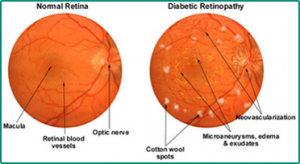In the January 18, 2003 issue of the Lancet (Lancet 2003; 361:195-200) Dr. Dr. Naveed Younis and his collegues published a study from the Royal Liverpool University Hospital, U.K. where diabetic patients underwent thorough eye examinations in regular intervals for 5 years. The question of this study was whether it mattered at what interval patients would be examined with regard to their eye-sight, so that perhaps blindness could be postponed or avoided through early interventions.
At the baseline of the study a special eye-photography method (three-field mydriatic photography) was used to document the blood vessel changes in the back of the eye. This helps the physician to assess whether or not there is a degree of retinopathy (blood vessel damage from diabetes) of the eyes or not. The investigators defined three groups:
For group one (no eye damage in the beginning of the study) there was a retinopathy rate of 0.3% at the end of the first year. Group two (moderate retinopathy in the beginning) showed a worsening of the retinopathy at the end of the first year of 5% (threatening blindness). Group three (significant retinopathy in the beginning) showed a rate of 15% of worsening retinopathy (threatening blindness) at the end of one year.
This shows that not every person with diabetes is equal with respect of having the threat of blindness. The medical investigators found that about 70% of patients fell into the group that did not have serious diabetic retinopathy. However, the other 30% would not do well with simply yearly eye examinations as it is recommended now. Instead the authors of the Liverpool study were able to make practical recommendations as follows:
After a baseline eye examination those who belong into group one would get an eye examination every 3 years. Those with prior moderate retinopathy (group2) on the initial baseline examination would get examinations at yearly intervals (until the degree of retinopathy worsens). Group 3 with significant retinopathy at the beginning would, however, be examined every 4 months (new recommendation) so that blindness hopefully could be avoided or significantly postponed through interventional therapies.
The following link is telling you about hardening of the artieries (arteriosclerosis) and how diabetes accelerates this process:
The following site is about the metabolic effects of diabetes on the body and in particular also about the danger of diabetic retinopathy:
Diabetes: http://www.nethealthbook.com/articles/hormonalproblems_diabetesmellitus.php
Last edited December 10, 2012






